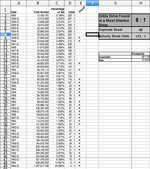Sleepy Holow
Bronze Member
- Feb 2, 2013
- 1,043
- 876
- Detector(s) used
- Never used one, but am interested
- Primary Interest:
- Other
So I was crunching some numbers concerning the probability of me filling another hole in my FDR folder. So I calculated the probability of a silver FDR find being a certain date and mint. I love taking data and making spreadsheets. All of my data is based on known mintage numbers. The odds of an random silver FDR find being a 1964D are 4:1 while the odds of the same unknown coin being a 1955 are a staggering 529:1.
Some known sources of error include people hoarding key dates, 1964 dimes having had the least amount of time to disappear in the 1946-1964 set, and not actually knowing how many of each date/mint are still in existence.
If you add up the probabilities of finding each hole left on the Most Wanted List, it comes out to about a 10.83% chance of finding one of them each time I come across a silver FDR. Not too bad...8:1 odds. So all I've got to do is find 9 dimes and I should be able to fill a hole! Or at least that's what was supposed to happen. I haven't been able to fill a hole for about a month now. That's no new FDR finds in the last 45 Silver FDRs. Well, if we take into account that there's an 89.17% chance that the found FDR is a duplicate, then the probability of this occurring 45 times in a row is 0.8917^45, or 173:1 odds. By my calculations, that's crazy unlucky! Hmmm..173:1 is good enough to break into the Top 15 toughest silver FDRs odds. Do I have a Top 15 Dime coming this week? Maybe, maybe not, BUT MAYBE! You never know what the next box will bring my friends...HH

For Your Viewing Pleasure: Silver FDR Dime Probability Chart
Some known sources of error include people hoarding key dates, 1964 dimes having had the least amount of time to disappear in the 1946-1964 set, and not actually knowing how many of each date/mint are still in existence.
If you add up the probabilities of finding each hole left on the Most Wanted List, it comes out to about a 10.83% chance of finding one of them each time I come across a silver FDR. Not too bad...8:1 odds. So all I've got to do is find 9 dimes and I should be able to fill a hole! Or at least that's what was supposed to happen. I haven't been able to fill a hole for about a month now. That's no new FDR finds in the last 45 Silver FDRs. Well, if we take into account that there's an 89.17% chance that the found FDR is a duplicate, then the probability of this occurring 45 times in a row is 0.8917^45, or 173:1 odds. By my calculations, that's crazy unlucky! Hmmm..173:1 is good enough to break into the Top 15 toughest silver FDRs odds. Do I have a Top 15 Dime coming this week? Maybe, maybe not, BUT MAYBE! You never know what the next box will bring my friends...HH


For Your Viewing Pleasure: Silver FDR Dime Probability Chart
Upvote
0




 These are the questions going through my mind, haha.
These are the questions going through my mind, haha.
